You are using an out of date browser. It may not display this or other websites correctly.
You should upgrade or use an alternative browser.
You should upgrade or use an alternative browser.
Indian Unit Line Workshop
- Thread starter Sandris
- Start date
Blue Monkey
Archon Without Portfolio
CAVALRY
Sowar is the general term for a cavalry trooper - armed with lances, tulwars (curved sabres), and firearms of the period. The sainthi (lance) has a handle & would commonly be used with an underarm swinging strike or stab. Imported firearms would generally be technologically a step or two behind the European armies. Locally produced firearms were custom made for individual warriors - tending to decoration while remaining functional.
Dressed in local clothing rather than standardized uniforms. Later uniforms such as Skinners Horse distinctive yellow dress evolved from the favored color of a local tribe, for example. Use civ color just about anywhere. A typical type of clothing (looks a lot like Sandris wip preview) is described in the Maratha section below. The Sowar in color on the middle right is a preview of other styles Ill be posting later for Sultanate & Sikh units.
There arent easy equivalents to European types such as hussars or dragoons. Cavalry roles, weapons, and tactics were ethnic/regional variants. Need light swift screening forces? Get the Marathas on your side.
Use Sikhs for skill with a wide variety of weapons & ability to fulfil infantry as well as mounted roles. Etc. Cavalrymen were elite warriors who carried multiple types of weapons. You can justifiably fill all your slots with regional variations of dress or similarly dressed units with different weapons.
thumbnail
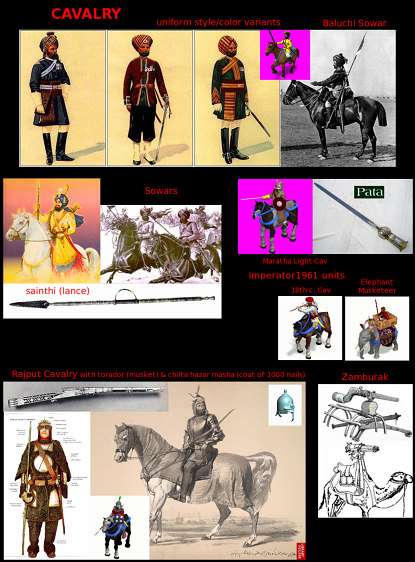
Suitable existing units (by Imperator1961)
Suggested additions
Sowar is the general term for a cavalry trooper - armed with lances, tulwars (curved sabres), and firearms of the period. The sainthi (lance) has a handle & would commonly be used with an underarm swinging strike or stab. Imported firearms would generally be technologically a step or two behind the European armies. Locally produced firearms were custom made for individual warriors - tending to decoration while remaining functional.
Dressed in local clothing rather than standardized uniforms. Later uniforms such as Skinners Horse distinctive yellow dress evolved from the favored color of a local tribe, for example. Use civ color just about anywhere. A typical type of clothing (looks a lot like Sandris wip preview) is described in the Maratha section below. The Sowar in color on the middle right is a preview of other styles Ill be posting later for Sultanate & Sikh units.
There arent easy equivalents to European types such as hussars or dragoons. Cavalry roles, weapons, and tactics were ethnic/regional variants. Need light swift screening forces? Get the Marathas on your side.
Use Sikhs for skill with a wide variety of weapons & ability to fulfil infantry as well as mounted roles. Etc. Cavalrymen were elite warriors who carried multiple types of weapons. You can justifiably fill all your slots with regional variations of dress or similarly dressed units with different weapons.
thumbnail

Suitable existing units (by Imperator1961)
- Indian 18th c. Cavalry (Sikh or other light cavalry using firearms)
- Marata Light Cavalry
- Elephant musketeer
Suggested additions
- Maratha Silladar with sainthi (short underarm lance)
- similar light cav with musket
- Baluchi Lancer
- Pata-wielding light cav in clothes of Tipu Sultan era
- Mounted musketeer in clothes of Tipu Sultan era
- Sikh with matchlock & tulwar (curved sabre)
- Rajput Heavy Cav - 1000 nail coat; armed with musket
- Zamburak - camel-mounted gun (ranged cavalry? mounted artillery?)
Spoiler :
Marathas - light cavalry
Silladars were gentlemen who provided their own horses, while Bargirs were supplied theirs by the state. Used mostly spears with a few matchlocks. 1/10 carried bows for attacks in situations where stealth was required. The pata is a Maratha sword - the handguard extends to become a half-bracer protecting the forearm. The flexible blade is swept to slash at any direction or angle. Video showing slashing techniques. Uniform: tight breeches, quilted coat, sash around waist & turban with one fold under chin. Extremely mobile - could cover up to 50 miles a day. Info is from By My Sword And Shield by E. Jaiwant Paul.
Lancers from Baluchistan would be another type of light cavalry. Note the holstered rifle in the photo.
Sikhs - Grenadier / Dragoon?
Zamburaks - swivel guns mounted on camels - were used from the days of crossbows up through the mounting of small gatling guns. The Sikhs deployed them in several local wars vs. the EIC/British.
Rajputs - Heavy Cavalry
Musketeers mounted on elephants are another type of heavy cavalry.
Silladars were gentlemen who provided their own horses, while Bargirs were supplied theirs by the state. Used mostly spears with a few matchlocks. 1/10 carried bows for attacks in situations where stealth was required. The pata is a Maratha sword - the handguard extends to become a half-bracer protecting the forearm. The flexible blade is swept to slash at any direction or angle. Video showing slashing techniques. Uniform: tight breeches, quilted coat, sash around waist & turban with one fold under chin. Extremely mobile - could cover up to 50 miles a day. Info is from By My Sword And Shield by E. Jaiwant Paul.
Lancers from Baluchistan would be another type of light cavalry. Note the holstered rifle in the photo.
Sikhs - Grenadier / Dragoon?
A European military observer wrote, "Their military force may be said to consist of cavalry... A Sikh horseman is armed with a matchlock (of large bore) and sabre of excellent metal (and also a spear), and his horse is strong and well-formed."
The Sikh manner of attack was called dhai-phat in their language---i.e. two-and-a-half strikes. A body of cavalry rides up to the enemy force, fires its matchlocks, and quickly rides away before reloading and returning to repeat these tactics. After the enemies have been thus softened, the entire mass of Sikh cavalry envelops them with a sudden rush and cuts them down with their swords.
Zamburaks - swivel guns mounted on camels - were used from the days of crossbows up through the mounting of small gatling guns. The Sikhs deployed them in several local wars vs. the EIC/British.
Rajputs - Heavy Cavalry
I guess the facing of the coat could be civ-color. In the illustration hes holding a musket. The b&w image just above him shows a similar type - The whole gun is metal with a lot of surface decoration. Imperator1961s unit is just included for comparison - its a different type of unit. but his Ottoman helmet with a couple of feathers added would do fine here.From central India and Rajputana came a more common form of fabric armour... There were two main patterns. Those entirely of quilted fabric... a long straight and full coat with with scalloped flaps over the shoulders and upper arms and high matching riding-boots. The padding generally consisting of layers of soft material and a thin one of cotton wool, faced with crimson or green velvet and lined with silk or satin. The surface of the whole was decorated with nails in a scale or diamond pattern... in some cases a layer of thin leather was laid beneath the velvet to give a firmer seating to the little nails, which were simply bent over at the back.
H. R. Robinson (Oriental Armour) on the 1000 Nail Coat
Musketeers mounted on elephants are another type of heavy cavalry.
Blue Monkey
Archon Without Portfolio
ARTILLERY
Imperator1961 has this pretty well covered. Be sure to use Imperator1961's rocket unit, at least as a UU. Tipu Sultan rocked the British army's world with them. Then Wellington stole the idea and Congreve made some that Wellington used at Waterloo. The elephant mounted artillery is authentic. Anthropologist/historians reconstruction video. The two additions I can suggest are a version of the sapper using a small field gun or mortar (not pictured) and a large Mughal field piece. The sultans liked their custom-made cannons to look like some fierce mythic creature. Besides the pictured boar Ive seen a dragon-scaled piece in an illo from a book on Wellingtons time India.
thumbnail
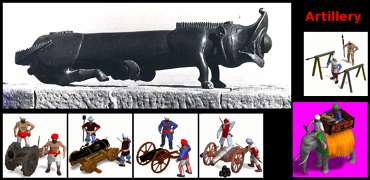
Suitable existing units (by Imperator1961)
Suggested additions
Imperator1961 has this pretty well covered. Be sure to use Imperator1961's rocket unit, at least as a UU. Tipu Sultan rocked the British army's world with them. Then Wellington stole the idea and Congreve made some that Wellington used at Waterloo. The elephant mounted artillery is authentic. Anthropologist/historians reconstruction video. The two additions I can suggest are a version of the sapper using a small field gun or mortar (not pictured) and a large Mughal field piece. The sultans liked their custom-made cannons to look like some fierce mythic creature. Besides the pictured boar Ive seen a dragon-scaled piece in an illo from a book on Wellingtons time India.
thumbnail

Suitable existing units (by Imperator1961)
- Four typical period artillery units
- Tube Rockets
- Elephant with swivel-mounted small cannon
Suggested additions
- Sapper with mortar (not pictured)
- Mughal cannon - barrel as stylized animal
Blue Monkey
Archon Without Portfolio
This post is mostly suggestions on uniforms for other units. Use the same weapons as previously mentioned.
Imperial Powers
Regular army units wore the same uniforms as in the European campaigns during this period. They hadn't figured out how radically different the climate was. Or at least hadn't designed uniforms for it. So use the standard units.
Private company armies (such as the East India company's three commands) had four basic types of soldiers:
Indian States
Local forces guns were often a step behind the latest European technology. Firearms being expensive or custom made were also scarce. Swords & lances were still used when guns were unavailable.
Units from the martial tribes such as the Gurkhas, Sikhs, or Marathas wore the clothing of their clan/caste/region. The more elite the troops the more standard the uniform becomes. Lots of other small ethnic groups from Nepal, Kashmir, etc. fielded forces similar to Gurkhas. So there can be a variety of units with similar weapons but distinctive clothing. Pictures are at hand if needed. There are quire few women who, as local rulers, commanded their tribes in battle or led a band of outlaws (dacoits) after defeat. So a soldier in a sari wouldnt be out of the question.
Suggested units
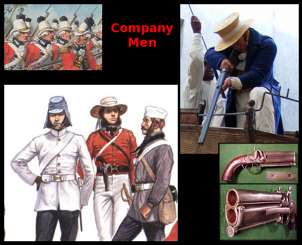
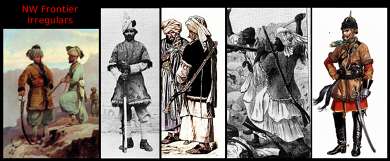
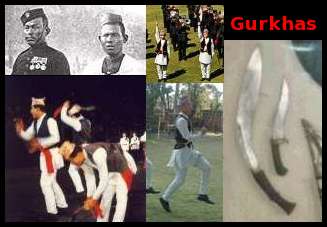

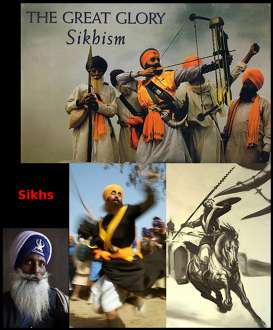

Hope there's enough here for a suitable pack of units. I've recently come across pictures of sepoys in some other uniform styles. Let me know if you want them posted, along with other ethnic styles for local units.
Imperial Powers
Regular army units wore the same uniforms as in the European campaigns during this period. They hadn't figured out how radically different the climate was. Or at least hadn't designed uniforms for it. So use the standard units.
Private company armies (such as the East India company's three commands) had four basic types of soldiers:
- Company representatives in distinctive hats & coats suitable for the local climate.
- Mercenaries / European cadre commanding native support troops: wear uniforms of their former affiliations - maybe use units similar to but not used as Euro regulars.
- Adaptations using some elements of local clothing such as the Afghan frontier irregulars putting fur-lined vests over their uniforms.
- Local militias - neither provided with guns nor uniforms. Definitely cannon-fodder. The illustrations cover Northern India through Sri Lanka.
Indian States
Local forces guns were often a step behind the latest European technology. Firearms being expensive or custom made were also scarce. Swords & lances were still used when guns were unavailable.
Units from the martial tribes such as the Gurkhas, Sikhs, or Marathas wore the clothing of their clan/caste/region. The more elite the troops the more standard the uniform becomes. Lots of other small ethnic groups from Nepal, Kashmir, etc. fielded forces similar to Gurkhas. So there can be a variety of units with similar weapons but distinctive clothing. Pictures are at hand if needed. There are quire few women who, as local rulers, commanded their tribes in battle or led a band of outlaws (dacoits) after defeat. So a soldier in a sari wouldnt be out of the question.
Suggested units
- Company soldier with distinctive Wellington/DOrsay hat & civ-colored coat.
- Company Man in blue or civ-color long coat and wide-brimmed straw hat with howdah gun (double-barrelled large-bore pistol).
- European irregular cadre (fur vest over uniform) with rifle or pistol & sword
- Afghan irregular with flintlock
- Gurkha with kukri : native irregular, not British commando or rifle.
- Sultanate lancer
- Sultanate musketeer
- Sikh with rifle, sword, bow or lance
- Dacoit woman with katar






Hope there's enough here for a suitable pack of units. I've recently come across pictures of sepoys in some other uniform styles. Let me know if you want them posted, along with other ethnic styles for local units.
Blue Monkey
Archon Without Portfolio
Just for grins, here's a nice picture of the EIC vs. Mysore at the siege of Cuddalore in 1783.
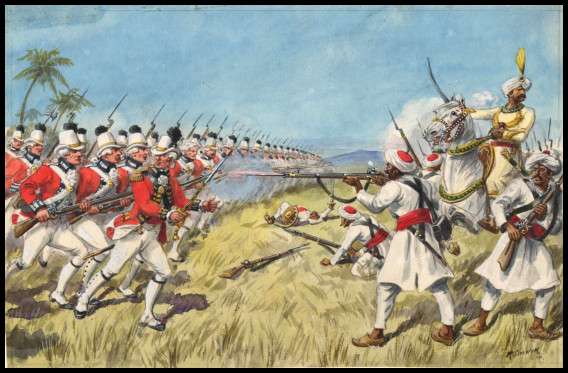

Blue Monkey
Archon Without Portfolio
Came across a brief mention of fighting elephant with chainmail & plate armor at the battle of Plassey (1757). Also, they were used during the whole Napoleonic period (& up until WWII) to pull limbers & caissons. Their size & strength let artillery be transported on steep mountain roads.
Are you going to make some GL &/or Army units? If so, do you want suggestions for India?
If the posted Napoleonic era info is helpful, could probably get Vedic era ready in a much shorter period of time, since images are at hand & mostly sorted, along with notes.
Are you going to make some GL &/or Army units? If so, do you want suggestions for India?
If the posted Napoleonic era info is helpful, could probably get Vedic era ready in a much shorter period of time, since images are at hand & mostly sorted, along with notes.
Don't know why no one has made comments yet, all these reference pics and specifications should be very useful. I hope Sandris (and others) are still reading this thread ! Very good work Blue Monkey, many of this info could be used for the Civilopedia articles too.
Blue Monkey
Archon Without Portfolio
Thanks. I'm sure their work continues. Most of us are still getting back up to speed from the holidays. For some that means catching up at work.
Yeap, catching up.
And having holidays! Having a life! Playing football! Card games! Eating a lot! This is what summer is all about!!!


And having holidays! Having a life! Playing football! Card games! Eating a lot! This is what summer is all about!!!
Who was that question aimed at? Was it an Area-of-effect attack or a single-target hitscan shot?Are you going to make some GL &/or Army units? If so, do you want suggestions for India?


Ares de Borg
Norman Knight
I'd love to see some of the previewed units finished. 

Virote_Considon
The Great Dictator
@Cimbri: There's a link to an Indo-Greek scenario which is somewhat in development in my sig, if you'd be up for collaborating ideas? 

@Cimbri: There's a link to an Indo-Greek scenario which is somewhat in development in my sig, if you'd be up for collaborating ideas?
Sure. Let's take it to the thread!


Okay! I refuse to believe that this might not ever be. So Ill let my obsessive nature get the better of me. Check out these sweet sweet Indian 3rd century BC Mauryans from the M:TW2 Europa Barbaroum II team.

Spearmen.
More units, Longbowmen, Swordsmen, etc:
Spoiler :

Longbowmen.

Swordsmen.

Macemen.

Horse Javelinmen

Chariot.

War elephant.
The Guardian
Praetorian
I hope so, I could really use these in my roman scenario.
The Guardian
Praetorian
I've been working on converting units from RTW with Imperator for my scenario/mod. Imperator is on vacation but should return soon and hopefully we can continue that process.
Blue Monkey
Archon Without Portfolio
That team has put a lot of work into their mod. Including a fair amount of historical research. Some of the written descriptions & accompanying unit images don't match their historical references. Why? It's clear from their unit parade that they've done a lot of reskinning of models from other factions - a necessary part of the modding limitations they have to work within. Meaning that a lot of the clothing, etc. is not specifically Indian - let alone Mauryan. All their work is very well-done in game terms. But don't expect a C3 conversion of a reskinned unit to be anything like historically accurate. They'd make good stand-ins until "3rd century BC Mauryans" can be made by someone - like Sandris - who pays careful attention to detail on each particular unit.Check out these sweet sweet Indian 3rd century BC Mauryans from the M:TW2 Europa Barbaroum II team.

Similar threads
- Replies
- 14
- Views
- 2K
- Replies
- 94
- Views
- 24K
- Replies
- 247
- Views
- 35K
